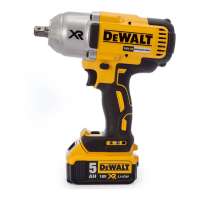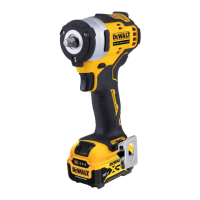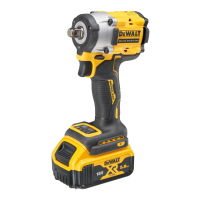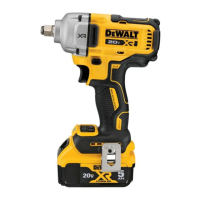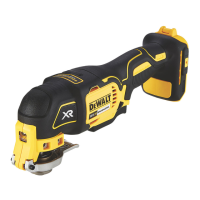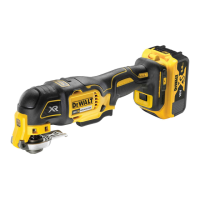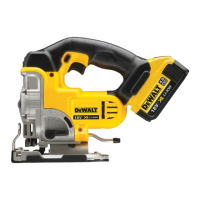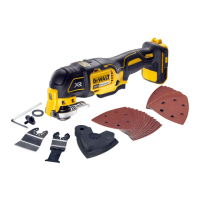11
ENGLISH
D
Cleaning
WARNING: Blow dirt and dust out of the main housing
with dry air as often as dirt is seen collecting in and around
the air vents. Wear approved eye protection and approved
dust mask when performing thisprocedure.
WARNING: Never use solvents or other harsh chemicals
for cleaning the non‑metallic parts of the tool. These
chemicals may weaken the materials used in these parts.
Use a cloth dampened only with water and mild soap.
Never let any liquid get inside the tool; never immerse any
part of the tool into aliquid.
C
Lubrication
Your power tool requires no additionallubrication.
MAINTENANCE
Your power tool has been designed to operate over a long
period of time with a minimum of maintenance. Continuous
satisfactory operation depends upon proper tool care and
regularcleaning.
WARNING: To reduce the risk of serious personal
injury, turn tool off and disconnect battery pack
before making any adjustments or removing/
installing attachments or accessories. An accidental
start‑up can causeinjury.
The charger and battery pack are notserviceable.
1. Place the accessory on the fastener head. Keep the tool
pointed straight at thefastener.
2. Press variable speed trigger switch
1
to start operation.
Release variable speed trigger switch to stop operation.
Always check torque with a torque wrench, as the fastening
torque is affected by many factors including the following:
‑ Voltage: Low voltage, due to a nearly discharged
battery, will reduce fasteningtorque.
‑ Accessory size: Failure to use the correct accessory size
will cause a reduction in fasteningtorque.
‑ Bolt size: Larger bolt diameters generally require
higher fastening torque. Fastening torque will also vary
according to length, grade, and torquecoefficient.
‑ Bolt: Ensure that all threads are free of rust and other
debris to allow proper fasteningtorque.
‑ Material: The type of material and surface finish of the
material will affect fasteningtorque.
‑ Fastening time: Longer fasten ing time results in
increased fastening torque. Using a longer fastening
time than recommended could cause the fasteners to
be overstressed, stripped ordamaged.
Usage (Fig. A)
CAUTION: Ensure fastener and/or system will withstand
the level of torque generated by the tool. Excessive torque
may cause breakage and possible personalinjury.
Proper Hand Position (Fig. E)
WARNING: To reduce the risk of serious personal injury,
ALWAYS use proper hand position asshown.
WARNING: To reduce the risk of serious personal
injury, ALWAYS hold securely in anticipation of a
suddenreaction.
Proper hand position requires one hand on the main handle
8
.
OPERATION
Instructions for Use
WARNING: Always observe the safety instructions and
applicableregulations.
WARNING: To reduce the risk of serious personal
injury, turn tool off and disconnect battery pack
before making any adjustments or removing/
installing attachments or accessories. An accidental
start‑up can causeinjury.
Anvil (Fig. A, D)
WARNING: Use only impact accessories. Non‑impact
accessories may break and cause a hazardous condition.
Inspect accessories prior to use to ensure that it con tains
nocracks.
CAUTION: Inspect anvils and hog rings prior to use.
Missing or damaged items should be replaced beforeuse.
Place the switch in the locked off (centre) position or remove
battery pack before changingaccessories.
To install an accessory on the hog ring anvil, firmly push
accessory onto the anvil
3
. The hog ring
12
compresses to
allow the accessory to slide on. After accessory is installed, the
hog ring applies pressure to help provide accessoryretention.
To remove an accessory, grasp the accessory and firmly pull
itoff.
greater control and reducing the chance of overtightening or
damagingmaterial.
When set in reverse, the tool will impact at a normal speed and
rate of 2200IPM. Upon sensing that the fastener has broken
free, the tool will cease to impact and will reduce speed to help
prevent “run‑off” of loosehardware.
Specifications
Mode Application RPM
Low Mode Normal Impacting 0–650 forward
0–2300 reverse
Medium Mode Medium Impacting 0–1040 forward
0–2300 reverse
High Mode High Speed Impacting 0–2300 forward
0–2300 reverse
Precision Wrench™ Mode Precision Wrench™ 0–820 forward
0–2300 reverse

